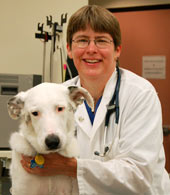Pet overpopulation can be prevented, says Iowa State University veterinarian
05-31-06
Contacts:
Dr. Kim Langholz, Veterinary Medicine, (515) 294-4900, langholz@iastate.edu
Teddi Barron, News Service, (515) 294-4778, tbarron@iastate.edu
Pet overpopulation can be prevented, says Iowa State University veterinarian
AMES, Iowa -- Every eight to 10 seconds, an animal is euthanized because there is no home available for it. This tragedy can be avoided, says an Iowa State University veterinarian.
Dr. Kim Langholz, a community practice veterinarian at the ISU Veterinary Teaching Hospital, says the birth rate for cats and dogs far exceeds the birth rate for humans. That means animal shelters, humane societies and other animal care organizations nationwide are swamped with unwanted animals.
"It's sad but true," Langholz said. "Too many cats and dogs are reproducing. And a tremendous number are being euthanized each year in this country."
According to the Humane Society of the United States and the American Society for the Prevention of Cruelty to Animals, between three and four million cats and dogs are euthanized each year. And an equal number die from injury, starvation or disease when they're released by owners who no longer want them.
"To provide homes for all of the unwanted or homeless animals, every family of four in the U.S. would need to have approximately eight dogs and 20 cats," she said. "Few households could manage 28 pets!"
A more realistic alternative is to spay and neuter.
"Our society needs to stop viewing cats and dogs as disposable items. They are not broken TVs or old cell phones that we can throw out when we no longer want them," Langholz said.
"Our taxes are paying the rising costs for public shelters to chase down loose animals and then house, feed and care for them," she said.
"And for the caring people who work in animal shelters, the frequent and repetitive demand for euthanasia of healthy animals is an unfair burden. It's demoralizing for them to repeatedly perform this procedure," Langholz said.
Langholz recommends that you do not let your cat or dog have 'just one litter.' She also suggests other ways to help the pet overpopulation situation:
- Become educated on pet overpopulation.
- Talk to family and friends about spaying and neutering their pets.
- Consider becoming an advocate for tougher spay/neuter laws.
- Adopt your next pet from the local humane society.
- Sponsor a fundraising event to help cover costs for the spays/neuters of pets owned by people on limited incomes.
- Volunteer at a shelter.
Additional information on overpopulation is available online:
The Humane Society of the United States http://www.hsus.org
The American Veterinary Medical Society http://www.avma.org
The American Society for the Prevention of Cruelty to Animals http://www.aspca.org
The National Council on Pet Population Study and Policy http://www.petpopulation.org
Spay USA http://www.spayusa.org
The Feral Cat Coalition http://www.feralcat.com
-30-
